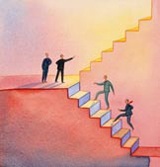At a recent chief learning officer (CLO) summit in Mumbai, guest speaker Emma Cunis, executive director of Chartered Institute of Management Accountants (CIMA), was part of a panel that discussed the cost of not investing in executive learning and development (L&D). She quoted former General Electric CEO Jack Welch to make her case: “The Jack Welch of the future cannot be like me. I spent my entire career in the United States. The next head of General Electric will be someone who spent time in Bombay, in Hong Kong, in Buenos Aires…. We have to send our best and brightest overseas and make sure they have the training that will allow them to be global leaders who will make GE flourish in the future.”
In the 1990s, when Welch made Steve Kerr CLO, GE became the first company to officially have such a designation. But Cunis’ point was this: Today, more than ever before, organizations are facing L&D challenges as they struggle to keep pace with change, foster deeper technical and professional skills in their employees, and operate in a global environment. For emerging economies like India, the problem is perhaps exacerbated as the concept and importance of corporate L&D driven by a CLO is not yet fully understood.
The two-day summit, themed “Organizational Learning: Impacting Business. Changing the Game,” is an initiative to spread awareness. The summit had more than 100 speakers, including traditional corporate human resources heads and others such as Nobel Peace Prize winner and director general of The Energy and Resources Institute (TERI) R.K. Pachauri, Australian cricket player Adam Gilchrist, and spiritual guru and founder of Vedanta Vision Jaya Row.
Lessons from Cricket
Gilchrist brought to the summit his experiences as part of a leadership group that helped steer the Australian cricket team to many successes. He shared insights on the importance of working as a team and putting in place clear parameters and templates for the team to operate both on and off the field. “By doing this, every member of the team knows what is expected of him and what his role in the organization is in any given situation,” he said. “These experiences are very transportable into everyday life and especially so in companies and business organizations. Working as a team and being accountable both as individuals and a group are essential for any team dynamic to thrive and will always form the platform for success — both on the sporting field and in the boardroom.”
Pachauri added a different dimension to the CLO discussions. In an interview after the formal summit, Pachauri emphasized the importance for organizations and individuals to rethink and restructure existing models, processes and methodologies in order to run successful sustainable businesses. “This calls for a great deal of innovation, unlearning and relearning by enhancing the scope for greater exchange of views,” Pachauri noted. “The CLO Summit India is one such platform where corporate leaders can discuss opportunities and challenges associated with these practices. The summit has undoubtedly brought the important issues of sustainability and corporate training to the fore.”
Growing Awareness
Summit organizer Kumaar Bagrodia, CEO of LeapVault, a Mumbai-based executive development and knowledge media organization, recalls the first edition of the summit held in 2009. Though attended by more than 200 L&D professionals from all over the country, the event had no designated CLOs participating. Three years later, the situation has changed somewhat: The summit did have a few official CLOs among the 340 attendees. But the big leap forward is that people attending knew what the acronym stood for.
“CLO is largely an American designation,” Bagrodia pointed out. “Very few organizations in India are using that nomenclature and are unlikely to do so even if the market matures a lot. However, there are chief talent officers or heads of learning playing that role. Of our attendees, at least two-thirds are heads of learning.” But the CLO ecosystem is being created fast, he added.
Since the nation’s economic liberalization in 1991, India’s corporate landscape has undergone rapid and dramatic change. Bagrodia conceptualized the summits as a platform for India Inc. to come together and share best practices related to learning and talent management, and to add value greater than the usual HR conferences, most of which, said Bagrodia, are “vanity scams”.
“For the first time ever, an entire nation is going to transform from an underdeveloped country to an emerging economy to a developed economy in one generation,” noted Bagrodia. “Every major corporate action in India is about change, be it business process transformation or mergers and acquisitions, rebranding, high growth or geographical expansion, and people don’t know how to deal with it.” The 100 or 200 top companies are able to manage change, Bagrodia said; the rest are floundering. “And as more HR functions begin to get outsourced, what remains at the core is learning. The business of learning is becoming very specialized and cannot fit easily within a larger HR context,” he suggested. “The management has to think, talk and behave differently. For example, the chief financial officer at Tata Motors required very different skills even five years ago than he does today. Change is the new normal.”
Bosch India is one company that has indeed felt the need to adapt. A. Krishna, senior vice-president for human resources, was among the panelists commenting for a discussion on the role of CLOs in organizations. “I think India is a country where the competence gap is very high between what businesses expect and what’s available, not just at the entry level but at all levels,” said Krishna after the discussion. “And, therefore, the importance and centrality of the learning function is increasing simply because incompetent or inadequately-competent people impact the bottom line.”
A Complex Role
Filling that gap is where a CLO, traditionally an esoteric function within the general HR realm, comes in. A CLO is commonly understood as being in charge of training, leadership development and organizational behavior, a role that has become more complex due to technology advancements, talent shortage and globalization. “The role of the CLO is to actually work on the competence architecture of every organization, and that means be a part of defining the competence framework; otherwise [the CLO is] just a delivery boy,” added Krishna.
Companies in India may take time to get there, but participation in the summit suggests that they have woken up. Vishal Khanna, head of organization capability at Tata AIG General Insurance, has been attending the CLO summits regularly “because it’s when you start looking outside that you get insights that will help you grow faster. In India, we’ve had homegrown specialists; we’ve always been very inward looking.” He sees himself as the CLO of his organization, though without the exact designation.
Among his most important roles and responsibilities as CLO, noted Khanna, is his ability to understand current capabilities not just in terms of employee skills, but also in terms of knowledge, behavior, leadership and building employability for the future. “When you look at it from the intention of moving forward, it’s about your ability to visualize what the industry is going to be five years from now. You have to invest toward that today.”
Mukul Saxena is senior vice-president for e-learning Services at Sify and also a regular CLO summit attendee. He also considers himself a CLO, although without the formal designation. He says a CLO carries out the part of HR that HR has not been able to execute with great focus. “The role of the CLO in India is developing because I think the potential that India has for skill development is what is bringing the learning industry to the fore,” said Saxena. “This is the natural outcome of India being looked upon by the rest of the world as a place where knowledge grows.”
Khanna and Saxena are among the new order of employees in India who think beyond remuneration. “India is in the middle of a massive boom in the services sector. Employees even in their first jobs are maturing in their needs for self-actualization, much quicker than blue-collar workers of the past because of their salary levels, the quality of work and workspace, the concept of an organization and so on,” noted Bagrodia.
Early Adopters
Perhaps the most surprising aspect of the CLO story in India is its acceptance in the typically staid, resistant-to-change public sector. “I think the sheer size of the organizations makes it imperative to invest in people development,” said Bagrodia. A lot of the private-sector executive talent in core sectors gained their initial experience in government undertakings, he added. Steel baron L.N. Mittal built up his global empire with the services of retired executives from the Steel Authority of India Ltd.
Among the speakers at the summit was K.B. Saha, executive director of the government-owned Life Insurance Corporation of India. “The CLO is possibly in the most advantageous position to contribute significantly to the formulation of business strategy and its effective implementation,” he said. “Regular contact with ground-level realities and awareness of environmental [political, economic, social and technological issues] in the industry makes him the most important resource person for mentoring and coaching senior management on these matters. The quicker this fact dawns on industry leaders, the better.”
There are also other peculiarities of the Indian CLO growth story. Developed Western countries have never had a problem like that of India’s large, unskilled population entering the modern workforce. “The onus to skill them is going to be on industry,” noted Bagrodia. “Second, our business models today and going forward are going to be different from those in the Western world. So people need to be trained differently. Third, the West has never seen this trajectory of globalization while themselves becoming globalized.”
But the common thread with the West is that even in India, CLOs will only find their rightful seat at the table if they can be held accountable for measureable business results. A survey of 92 chief learning officers in large corporations, conducted by The University of Pennsylvania and the American Society for Training & Development (ASTD) in 2006 found that a CLO’s biggest challenge is communicating and measuring the value of learning. According to the study, “there are many paths to becoming a CLO, and the role requires a combination of business savvy and knowledge of key areas of the learning field. Many CLOs are strong in one but not both of those areas.”
“Twenty years in HR does not mean you can become a CLO,” said Bagrodia. “The demand of the market, competitive intent or employee behavior will mean that you need a high-end specialist in the CLO role.” This means higher costs as training budgets go up. But there is no choice, Bagrodia added. “Going forward, there is only going to be learning; HR is dead.”



